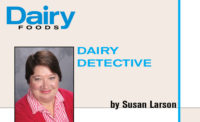Could your company endure the product losses due to a recall? Perhaps yes. But could your company survive the market’s loss of trust that might follow a public safety crisis? The response to that question may be less certain.
One key to minimizing damage in the event of a food safety incident is to develop a traceability program that will enable your company to quickly and definitively either eliminate you as a source or identify the source of the problem, and then take swift action to minimize the impact.
The Innovation Center for U.S. Dairy, Rosemont, Ill., (established by American dairy farmers) has defined voluntary best practices for enhanced dairy traceability. Adoption of these practices and protocols will allow dairy companies to fully and quickly trace products and ingredients from farm to customer and ultimately will strengthen the dairy supply chain. In today’s highly competitive global food market, traceability has emerged as an integral component of a consistent supplier strategy.
Why traceability
Robust traceability programs will allow the dairy industry to quickly isolate products to protect public health and prevent brand damage and will help the industry to control its destiny and increase global competitiveness. Traceability also is the law under the Food Safety Modernization Act.
“FSMA imposed a number of traceability requirements on FDA which are still in the early stages of development. Despite uncertainty in how things will play out, it is clear the status quo is not acceptable,” said Clay Detlefsen, vice president of regulatory affairs and counsel for the International Dairy Foods Association, Washington, D.C. “FDA would strongly prefer industry to act and enhance its traceability and obviate the need for FDA to take action. We can and should control our destiny.”
A vibrant traceability program also is critical to increase the global competitiveness of domestic dairy ingredients. In 2013, more than 15% of total U.S. milk solids were exported, according to the U.S. Dairy Export Council. Key competitors in Oceana and Europe already have begun to communicate their commitment to traceability. Domestic producers also must show their commitment to enhanced traceability.
3 pillars of best practices
The Innovation Center Traceability Committee has laid out three pillars of dairy traceability.
First, dairy companies need to model their physical plants to know where new lots enter and where products transform. A key data element (KDE) is a place in your facility where bulk products, ingredients or packaging materials are added to make your final product.
Second, companies need to create a lot identifying mark (Lot ID) that will be recognized and used by customers. A simple, human-readable Lot ID accurately recorded on every package, container, pallet and bill of lading is the key element in a successful traceability system. The words “LOT” or “Lot ID” should precede the mark so that customers can identify the Lot ID.
Third, dairy companies need an enhanced record-keeping system that will assist in expedient recall capability.
A good traceability program should allow a manufacturer to perform three key tasks: find the source of an issue; find the common point of convergence of products within an issue; and find all the products that contain that common point of convergence across the corporation.
To perform a product trace depends upon your ability to quickly categorize your production into three groupings: inclusion, exclusion or dilution. Inclusion is the ability to include any product(s) that could contain any trace of a possible contaminant. Exclusion is the ability to exclude the products that do not contain any contaminant. Dilution is the separation of products that may have a large amount of the contaminant from those that may only have possible traces.
Take the traceability pledge
To date, companies representing 25% of domestic fluid milk production have committed to the voluntary guidelines. Each agreed to sign the U.S. Dairy Traceability Commitment, which can be found at the Innovation Center’s traceability best practices page at USDairy.com. These organizations are Darigold, Glanbia Foods, Hilmar Cheese, Leprino Foods and Michigan Milk Producers Association.
“Our target is to have an 80% adoption rate across the dairy industry by September 2014,” said Jeremy Travis, vice president of operations with Hilmar Cheese Co. and Hilmar Ingredients.
Other key components of the Innovation Center’s program to enhance U.S. dairy supplier status include food safety workshops and crisis training. The 2014 plan includes five dairy plant food safety workshops, as well as new resources, training and preparedness tools for national and local crisis plans.
For the full report, “Guidance for Dairy Product Enhanced Traceability,” and a traceability checklist, visit www.dairytraceability.com. Vikki Nicholson, at the U.S. Dairy Export Council also can answer questions. Email her at vnicholson@usdec.org.




